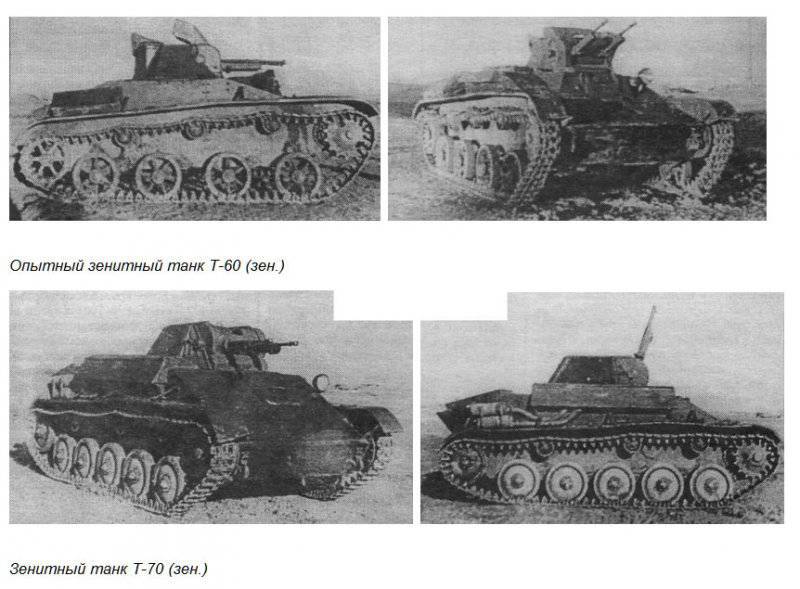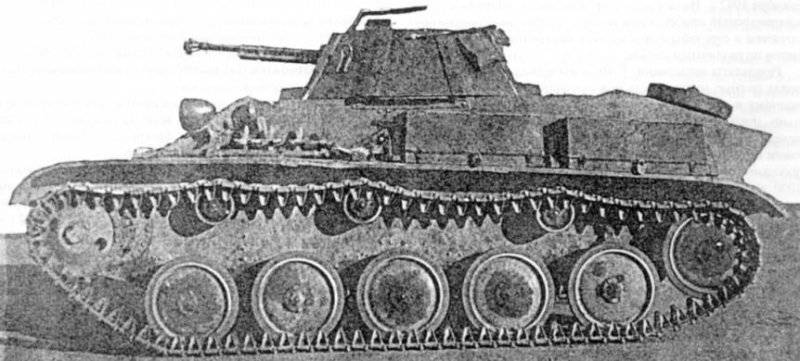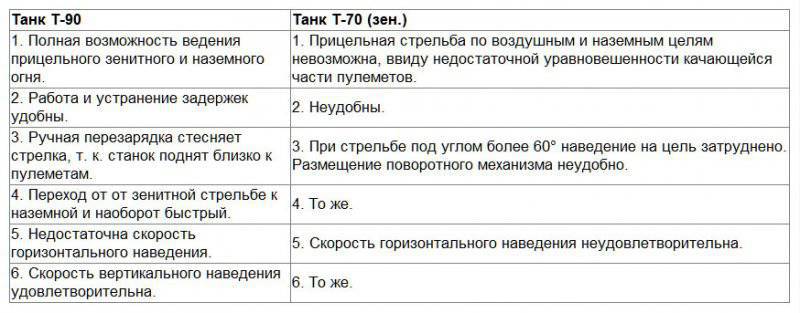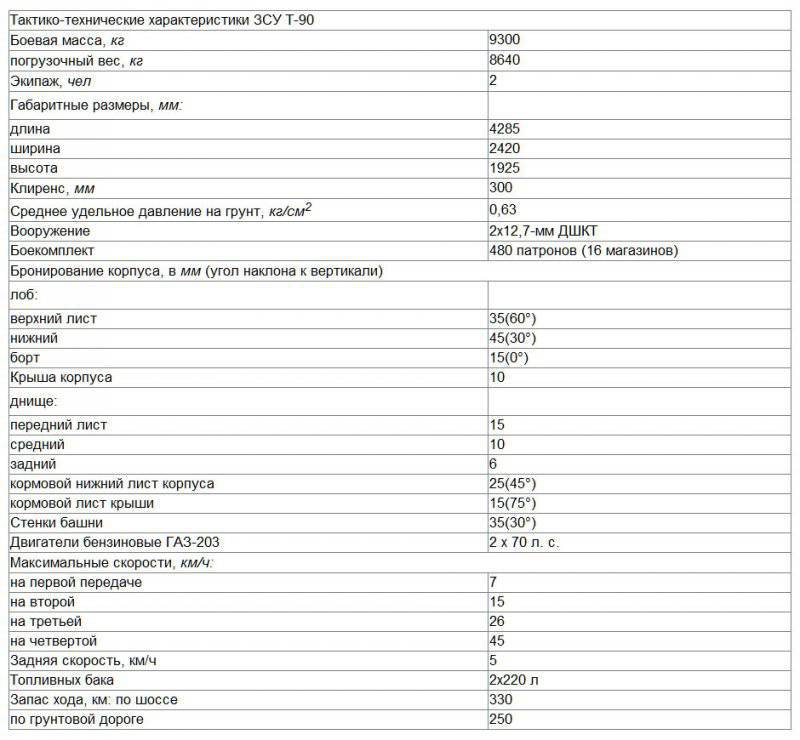Attempt to create anti-aircraft tanks during the Great Patriotic War
In 1940, the Mk1 and Mk2 anti-aircraft guns appeared on the base of the MkVI light tank. They were armed with four 7,92-mm or 7,62-mm machine guns or two 15-mm machine guns. In 1942, the British already had an “anti-aircraft tank” “Kruseider AA” with a pair of 20-mm machines in the turret. The 6-8 of these vehicles was attached to each tank regiment.
We in the 30-s worked out ZSU, armed with 76,2-mm anti-aircraft gun based on the T-26 tank. But the prototypes did not go further than that, and our tanks did not have any mobile air defense weapons. Only after 1943, the Red Army began to receive American machine-gun and cannon ZSU M16 and M19 on the basis of semi-tracked armored personnel carriers. But the ZSU was urgently needed, and it should be armored vehicles, i.e., protected at least from bullets and fragments and having the same maneuverability as tanks. The four-barreled installations of the Maxim machine-guns on the basis of trucks were not suitable for these purposes. For the ZSU, it was necessary to choose a tank base, preferably a light one, which would speed up and cheapen their production.
There was no need for solid body armor, because there was no need for them to attack the enemy positions under the fire of anti-tank guns.
In 1942, our industry produced in large quantities light tanks T-60 and T-70. It was on their base that it was decided to create a machine gun ZSU, armed with a pair of 12,7-mm machine guns DShK. DShK has shown itself as an effective means of air defense, which has a high rate of fire and a sufficient height range. Machine guns DShK with the same success could be used on ground targets and lightly armored armored personnel carriers. Necessary requirements were the possibility of conducting a circular attack and a large angle of elevation. Machine guns were supposed to be installed in a light-armored turret, open from above for firing anti-aircraft fire and a free review of the air situation by the gunner.
GAZ plants (Gorky), belonging to the People's Commissariat of Medium Machine Building, and No. XXUMX (Sverdlovsk), which belongs to the People's Commissariat of the tank industry, dealt with these works from 1942.
By order No. 0107 from September 16 of 1942, the GABTU and the Red Army GAU set up a commission chaired by Lieutenant Colonel Nenarokov and ordered it to conduct tests of the ZSU prototypes as soon as possible. The commission also included the chief designer of GAZ and plant No. XXUMX N.A. Astrov, from GAZ - Maklakov, from NKTP - I.V. Savin At the tests, which took place in the second half of September, three samples were presented at the NIIBT test site in Kubinka. GAZ presented on the basis of its serial light tank T-37 ZSU, which then received the unofficial name T-70 (that is, still an anti-aircraft tank!). On it in a specially designed, welded, octagonal turret without a roof was installed Sparky 90-mm machine gun DSHKT. The turret was used by the standard T-12,7. Plant No.70 presented a machine called the T-37 (zen.). On it, the Sparka DShKT was installed in a converted standard turret of the T-70 tank on the standard brackets of the T-70 tank in a special mask-armor. On T-40 machine guns were placed to the right of the longitudinal axis of the turret on the machine in a special mask-bronoszashite.
Anti-aircraft tank T-90
On the T-70 (zen.) Machine guns stood symmetrically to the longitudinal axis of the tower. Plant №37 presented and the machine T-60 (zen.) With a converted standard tower. In all cases, store-powered food: T-90 480 ammunition (16 stores), T-70 (zen.) - 360 cartridges. Both vehicles were equipped with a TMPP telescopic sight for firing at ground targets at elevation angles -6 °, + 25 ° (for T-90) and -7 °, + 25 ° (for T-70 zen.), And also a collimator sight K-8T for firing at air targets within elevation angles + 20 °, + 85 °. The height of the line of fire is 1605 (T-90) and 1642 (T-70 zen.) Mm. Horizontal aiming on the T-90 gunner carried out with his left hand (6 ° for one revolution of the handwheel). Vertical guidance - with the right hand lifting mechanism (10 ° per turn). The T-70 (zen.) Has horizontal right-handed guidance (3 ° per turn) with a standard turning mechanism from T-70, vertical - free, with the left hand. At T-60 (zen.) Vertical and horizontal pickups are free. T-60 (zen.) Due to improper installation of the collimator sight to the tests was not allowed. Even the motor was not installed on it. It was noted that in the tower closely, with ground firing, machine guns press the arrow to the tower chase (vertical and horizontal guidance — free). Its combat mass could make 6,5 t. Further, it will not be discussed.
Tower T-70 (zen.) Had a roof, a modified embrasure and welded mask thickness 35 mm. Gas piston machine guns with a tube were booked. The trigger of the machine guns on the T-90 had a left pedal for the left and right for the right machine guns. At T-70 (zen.) - regular from T-70, i.e. paired pedal for two machine guns. The T-90 was equipped with a closed sleeve receptacle with the reflection of the sleeves and their direction along flexible sleeves into a box on the tower floor. In the T-70 (zen.), A sleeve was used, but there was no sleeve and a head catcher.
The inoperable space of the T-90 and T-70 (zen.) Machine guns in the forehead was 22,6 and 9,75; in the stern - 21,8 and 14,8; on the left side —19,5 and 14,35; on the starboard side - 27,3 and 12,5 m, respectively.
On T-70 vehicles, the driver had a periscope viewing device with an 90 ° horizontal view. The commander, located in the turret, led the observation through a telescopic sight, and on the T-90 and over the walls of the turret.
Engine - serial, but envisaged installation and forced to 85 l. with. (at 3600 rpm) motors. Double-clutch dry. Onboard multidisk clutches dry. Transmission manual - four speeds forward, one - back.
Conducted only shooting tests. Sea trials were unnecessary, since the characteristics of the base machines were well known. The results of the shooting were as follows:
In addition, there were frequent delays in machine guns when firing.
“The act of the Comparative Testing Commission for shooting a 12,7-mm machine gun on T-90, T-70 and T-60 tanks” (September 1942) contained the following conclusions:
Installing the WBD in the T-90 allows you to repel air attacks in the parking lot and on the march and fight with firing points.
Tests by shooting and mileage showed sufficient strength and reliability of the T-90.
Accuracy and accuracy of shooting turned out to be lower than possible and unsatisfactory for T-90 (zen) in T-70.
It is convenient to use the T-90 guidance mechanisms, while the T-70 (Zen.) Is inconvenient.
It is inappropriate to rework the T-70 serial towers, since the volume of rework is approaching the production of a new tower. The design of the serial tower does not provide satisfactory fire control. The large size and weight of the standard T-70 tower does not allow to achieve the necessary maneuverability by fire.
It is necessary to increase the speed of horizontal pickup at T-90 to 10 ° by one revolution of the handwheel.
Zoom ammunition T-90 to 1500 ammo in stores and zinc.
The tower T-90 with minor design changes can be installed in the tank T-60.
It is noted that the bodyguard - a mask of machine guns on the T-90 protects the shooter from bullet damage. On T-70 (zen.) Due to the large hole for the sight, such protection is not provided. In addition, the T-90 was equipped with a 9R transceiver station located on the floor of the tower. The strike was on the left side.
The Commission gave a clear preference to the T-90, but noted the need to significantly fine-tune the machine to the required conditions. However, the work on the creation of the ZSU machine-gun was abandoned due to the low power and low accuracy of the fire of the two-caliber heavy machine guns.
At plant number XXUMX and GAZ, work was already underway to create a ZSU-37 on a slightly modified T-37 base. This system was more stable, had a greater reach in height and a much more powerful projectile. True, the ZSU-70 entered service only at the end of the war.
The work on the machine gun ZSU still had a positive result: the towers with a roof designed for T-70 (zen.) With a roof for the DShK were slightly improved and installed on armored and armored trains.




Information